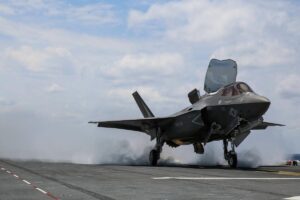
WASHINGTON: In a major speech outlining important strategic shifts for the United States, the Chairman of the Joint Chiefs, an Army general, today predicted “a lot of bloodletting” in the Pentagon as the military strives to get the Navy the hundreds of new ships it says it needs to confront China.
“I would advocate, and bias going forward, heavy investment” in sea, air and space-centric platforms, Milley said. As for the other priorities, he said, “none of it gets cut to zero; this is a matter of balancing things. It’s a very, very difficult exercise we’re going to have to go through. It’s going to be ruthless, there’s going to be a lot of bloodletting and a lot of stuff left on the floor. We’re gonna have to do that in the coming years — no question about it.”

President Trump with the future Chairman of the Joint Chiefs, Gen. Mark Milley, and the future Defense Secretary, Mark Esper, at the 2018 Army-Navy game
Milley’s comments indicate the Army is likely to be the loser in the coming budget wars.
There have been rumblings for weeks that the new Navy shipbuilding plan, which calls for a fleet of about 500 ships, would be impossible under current budget projections, leading the Pentagon to eye Army and Air Force accounts to make up the difference.
Milley all but confirmed that.
“I don’t want to reveal my cards,” on the numbers being considered, he said at a virtual Navy Institute event. “But I probably already did by saying we’re a maritime nation. We are, and the defense of the United States depends on air power and sea power primarily. People can say what they want and argue what they want, but that’s a reality.”
The irony of Milley’s comments is the deep skepticism within the ranks of the Navy when Mark Esper, a former Army officer and Army Secretary, and Milley, a 4-star Army general and Chief of Staff of the Army, took over the top civilian and uniformed posts at the Pentagon in 2019.

Marine Corps F-35B landing on the USS Wasp
But in the end, it might just be Esper’s demands that the Navy grow quickly and extensively — beyond what even the admirals were asking for — that will buttress the Navy and put a dent in the Army’s budget.
“So, look, I’m an Army guy,” Milley said. “And I love the Army…but the fundamental defense of the United States, and the ability to project power forward [are] going to be naval and air and space power.”
As Chairman of the Joint Chiefs, Milley provides his best military advice to civilian policy makers and presides over the uniformed heads of the five military branches. His doorway into both the Oval Office and the Defense Secretary’s suite gives him a unique window into how strategy is shaped and debated, and today he made clear where he believes money should be spent.
The chairman spoke the same day that Navy leaders were to brief the Pentagon’s new shipbuilding and modernization plan, dubbed Battle Force 2045, to Congress. The project, pushed by Esper before he was fired last month, would grow the Navy to at least 500 ships, including at least 150-200 unmanned vessels.
Whatever the details of the plan are, it’s sure to cost more money than the Navy can currently spend.
With budgets across the federal government expected to remain flat, or even decrease due to economic pressures caused by the COVID pandemic, that money would have to come from other parts of the Pentagon budget.
“An all-out interservice fight over the budget has been in the making for years now,” Todd Harrison, the defense budget expert at CSIS, said. The coming flat defense budgets will actually feel like a decline to the services because of so many baked-in operations and maintenance costs, he predicts. “If the Navy grows, then that means the other services will have to get much smaller. Ultimately, I think the Army is likely to be the biggest loser in this fight, as it was at the end of Korea, the end of Vietnam, and the end of the Cold War.”
The White House might add as much as $16 billion to the Navy’s shipbuilding budget in 2022, sources suggest, with as much as $10 billion of that coming from elsewhere in the Pentagon. We recently reported that the Army and Air Force are likely to be bill payers. The White House requested $19 billion for shipbuilding in the 2021 budget, meaning the 2022 ask could potentially come in at over $30 billion.
Navy Secretary Kenneth Braithwaite said last month he and Esper had developed a plan to fund the new fleet through a mix of Navy and Pentagon money. Esper has indicated the shipbuilding account could grow from 11% of the Navy budget to 13%, a move that would push the account to roughly $27 billion, but the new numbers suggest that could go even higher if the navy and other parts of the Pentagon cut deeply enough.
It was notable that both Milley, and Chief of Naval Operations Adm. Mike Gilday today each rejected suggestions the Navy would try to reduce the number of super carriers below the currently legally mandated eleven. The massive flat tops can project consistent air power like no other ship in the world, but the slow vessels are also increasingly seen as relatively lightly-defended targets for long-range Chinese missiles.
Speaking before Milley at the same conference, Gilday said the new plan calls for keeping “the line of supercarriers to remain around 11,” while Milley said “we’ll stick with the 11 for now until we have something else.” Esper in recent months had suggested the number of carriers could fall to about eight.
Another aspect of the plan revealed by both Milley and Gilday is the desire to build as many as six “light” carriers, similar to the Navy’s current amphibious ships, to ferry F-35Bs across the globe. The ships would be much smaller than the current carriers, making them more nimble and harder to target in the expanse of open ocean, though it is unclear what their final size or shape might be. “We know we need to be smaller, more distributed and equally as lethal” as the larger ships, Milley said.
Pentagon officials have said they expect some kind of public release of the new Navy plan in coming weeks.
The Pentagon is now finalizing its budget request for 2022, and it’s in this document we can expect the promised “bloodletting.” Meanwhile, House and Senate conferees just announced agreement on a defense policy bill for fiscal year 2021 (the National Defense Authorization Act, as distinct from the defense appropriations bill) which authorizes nine new Navy ships — including two Virginia-class attack submarines, twice what Trump requested — and creates a $2 billion Pacific Deterrence Initiative to “send a strong signal to China.”
Whatever the 2022 plan might say, it will surely be reconsidered by the Biden administration when it assumes power in January. President-elect Joe Biden has yet to select his nominee to be Secretary of Defense, but indications are it may be Michele Flournoy, who has expressed a willingness to meet China head-on.
“We have to have enough of an edge, that first and foremost we can deter China from attacking or endangering our vital interests and our allies. That means resolve,” Flournoy told Defense News recently.
The former CENTCOM commander, Gen. Lloyd Austin, and the Obama-era head of the Department of Homeland Security and general counsel of the Department of Defense, Jeh Johnson, are also in contention for the job.
GD chief says Navy’s 1 sub buy won’t impact company short term, but out years less certain
The comments from the General Dynamics chief come on the same day President Joe Biden signed the national security supplemental, which includes billions for the sub industrial base.



























